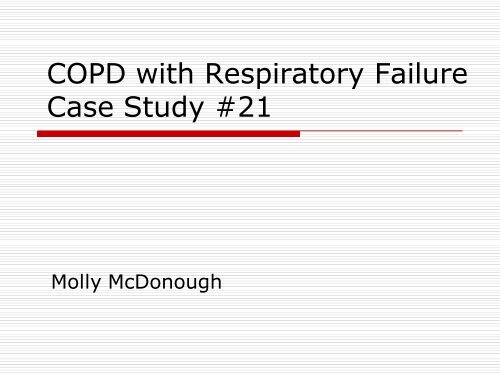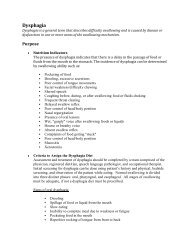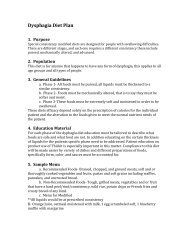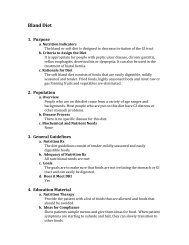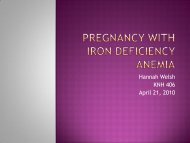COPD with Respiratory Failure Case Study #21 - Medical Nutrition ...
COPD with Respiratory Failure Case Study #21 - Medical Nutrition ...
COPD with Respiratory Failure Case Study #21 - Medical Nutrition ...
Create successful ePaper yourself
Turn your PDF publications into a flip-book with our unique Google optimized e-Paper software.
<strong>COPD</strong> <strong>with</strong> <strong>Respiratory</strong> <strong>Failure</strong><br />
<strong>Case</strong> <strong>Study</strong> <strong>#21</strong><br />
Molly McDonough
Patient:<br />
Mr. Hayato<br />
65 year old male<br />
Brought to ER <strong>with</strong> severe SOB<br />
Past History of emphysema<br />
Longstanding chronic obstruction<br />
pulmonary disease (<strong>COPD</strong>)<br />
• Secondary to tobacco use<br />
Still smokes<br />
2 PPD, 50 years
Diagnosis:<br />
Acute respiratory distress<br />
<strong>COPD</strong><br />
Peripheral vascular disease
Hospital Stay:<br />
In ER, endotracheal intubation occurred<br />
and patient was placed on ventilator at<br />
15 breath/min <strong>with</strong> FiO2 at 100%<br />
<br />
ABGs were used each morning to guide setting on<br />
ventilator<br />
Enteral feeding started on day 2<br />
High gastric residuals TF was<br />
discontinued, PPN started<br />
Day 4, TF started again and PPN<br />
discontinued day 5
<strong>COPD</strong> Facts<br />
4 th leading cause of death<br />
Smoking is primary risk factor<br />
• ~80-90% <strong>COPD</strong> deaths are caused by smoking<br />
Other risk factors:<br />
• Exposure to air pollution, second-hand smoke and<br />
occupational ducts and chemicals<br />
• History of childhood respiratory infections<br />
• Heredity, deficiency of ATT-protein which protects<br />
the lung against destructive actions
<strong>COPD</strong> Etiology<br />
Progressive disease<br />
Referring to two<br />
diseases<br />
• Emphysema<br />
• Chronic Bronchitis<br />
Both usually<br />
co-exist in <strong>COPD</strong><br />
http://www.shoppingtrolley.net/images/anatomy/lungs.jpg
Emphysema<br />
Destruction of air sacs (alveoli) where<br />
O and CO2 are exchanged<br />
Damage is irreversible<br />
As sacs are destroyed, less oxygen is<br />
able to transfer, causing SOB<br />
Lungs lose elasticity, which is<br />
important to keep airways open<br />
Exhaling is difficult because air<br />
become trapped in the lungs
Chronic Bronchitis<br />
Inflammation and scarring of lining of<br />
the bronchial tubes<br />
Decreased air flow<br />
Heavy mucus is coughed up<br />
Defined as the presence of a mucusproducing<br />
cough most days of the<br />
month, 3 months a year, for 2 years<br />
<strong>with</strong>out underlying disease explaining<br />
the cough
Diagnostic Measures<br />
Spirometry<br />
• Simple, noninvasive breathing test<br />
• Measures volume of air coming out of<br />
the lungs and how fast it can be blown<br />
out<br />
• Can detect <strong>COPD</strong> before symptoms<br />
become severe
Measures of Pulmonary Function<br />
Physical examination using<br />
stethoscope listening for different<br />
sounds<br />
Pulse oximetry<br />
• Light waves measure the oxygenation of<br />
arterial blood
Treatment<br />
Lifestyle changes<br />
• Smoking cessation<br />
• Avoiding smoke and air pollutants<br />
• Exercising as tolerated<br />
• Good nutrition<br />
Meds to prevent and control<br />
symptoms<br />
Pulmonary rehab
<strong>Nutrition</strong> Therapy<br />
Malnutrition occurs in 24%-35% of<br />
patients <strong>with</strong> <strong>COPD</strong><br />
Weight loss of 5%-10% of UBW<br />
Associated <strong>with</strong> increase REE because<br />
of the work to breath, reduced<br />
nutrient intake, and inefficient fuel<br />
metabolism
ADIME<br />
Assessment:<br />
• 65 year old male <strong>with</strong> <strong>COPD</strong><br />
• 13# wt. loss before admission; decrease appetite<br />
• Admit wt=122# Ht=5’4” BMI=20.9<br />
• UBW=135# IBW=130#<br />
• Usual diet supplying ~845 kcal and 51g PRO<br />
• Estimated needs :<br />
1590 kcal (based on Irenton-Jones)<br />
66.5-94.4 g PRO (1.2-1.7g/kg)<br />
Fluid: 1,942.5 mL (35mL/kg)
ADIME<br />
Diagnosis: PES<br />
• Inability to consume oral intake related to<br />
medical interventions because of acute<br />
respiratory distress as evidence by patient<br />
being ventilated at 15 breath/min <strong>with</strong> a<br />
FiO2 at 100%<br />
• Inadequate caloric intake related to<br />
decrease appetite caused by symptoms from<br />
<strong>COPD</strong> as evidence by patient usual diet<br />
intake supplying 53% of needs and 13 lb<br />
weight loss
ADIME<br />
Intervention: Tube Feeding Prescription<br />
Isosource<br />
• Goal: 55cc/hr continuously over 24 hours<br />
• TF ~80% free water supplying ~1056 cc free<br />
water; bolus ~844cc H2O to meet water<br />
requirement<br />
• Start at 20cc/hr, advance as tolerated every<br />
8 hours by 10cc until goal met at 55cc/hr<br />
• Provides: 1,584 kcal, 56.8 g PRO, and 1,900<br />
cc free water
ADIME<br />
Monitor/evaluation<br />
• TF tolerance and gastric residuals<br />
• Labs, weight<br />
• ABG, specifically CO2<br />
If increased indicated of being overfed <strong>with</strong><br />
carbohydrates<br />
Cause complications on vent
Questions?
References<br />
<br />
<br />
<br />
<br />
<br />
<br />
<br />
<br />
<br />
<br />
<br />
<br />
Association, American. (2008). International dietetics & nutrition terminology (idnt) reference<br />
manual: standardized language for the nutrition care process. Chicago, IL: 2008-06-15.<br />
Chronic obstructive pulmonary disease (copd) fact sheet. (2010, February). Retrieved from<br />
http://www.lungusa.org/lung-disease/copd/resources/facts-figures/<strong>COPD</strong>-Fact-Sheet.html<br />
Copd. (2008, June 14). Retrieved from http://www.copd-international.com/<strong>COPD</strong>.htm<br />
Getting tested. (n.d.). Retrieved from http://www.nhlbi.nih.gov/health/public/lung/copd/whatis-copd/getting-tested.htm<br />
Indiana Family & Social Services Administration. (n.d.). Health and safety: aspiration<br />
prevention. Retrieved from http://www.in.gov/fssa/files/aspiration_prevention_8.pdf<br />
Nelms, Marcia, Long, Sara, & Lacey, Karen. (2008). <strong>Medical</strong> nutrition therapy. Belmont, CA:<br />
Wadsworth Pub Co.<br />
Procalamine. (2008, December 18). Retrieved from http://www.rxlist.com/procalaminedrug.htm<br />
Pronsky, Zaneta. (2008). Food medication interactions. Birchrunville, PA: Food Medication<br />
Interactions.<br />
<strong>Respiratory</strong> quotient. (2010). Retrieved from<br />
http://www.chemie.de/lexikon/e/<strong>Respiratory</strong>_quotient/<br />
Rolfes, Sharon, Pinna, Kathryn, & Whitney, Ellie. (2008). Understanding normal and clinical<br />
nutrition. Belmont, CA: Brooks/Cole Pub Co.<br />
Tharp, R. (2010). Complications of enteral nutrition . Retrieved from<br />
http://www.rxkinetics.com/tpntutorial/2_3.html<br />
Total parenteral nutrition worksheet. (2007). Retrieved from<br />
http://www2.sunysuffolk.edu/mccabes/nr33%20tpn%20worksheet2007.pdf


